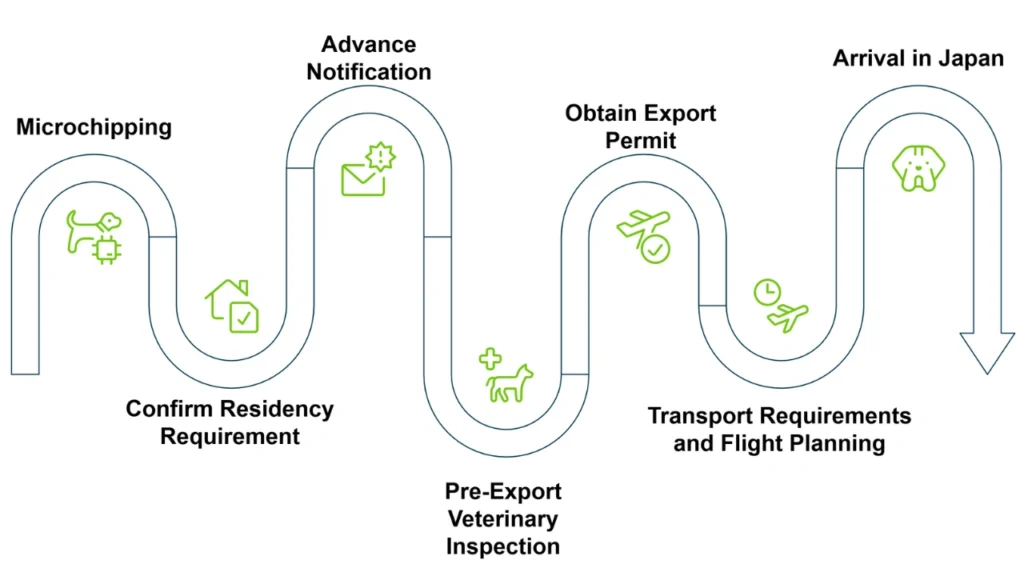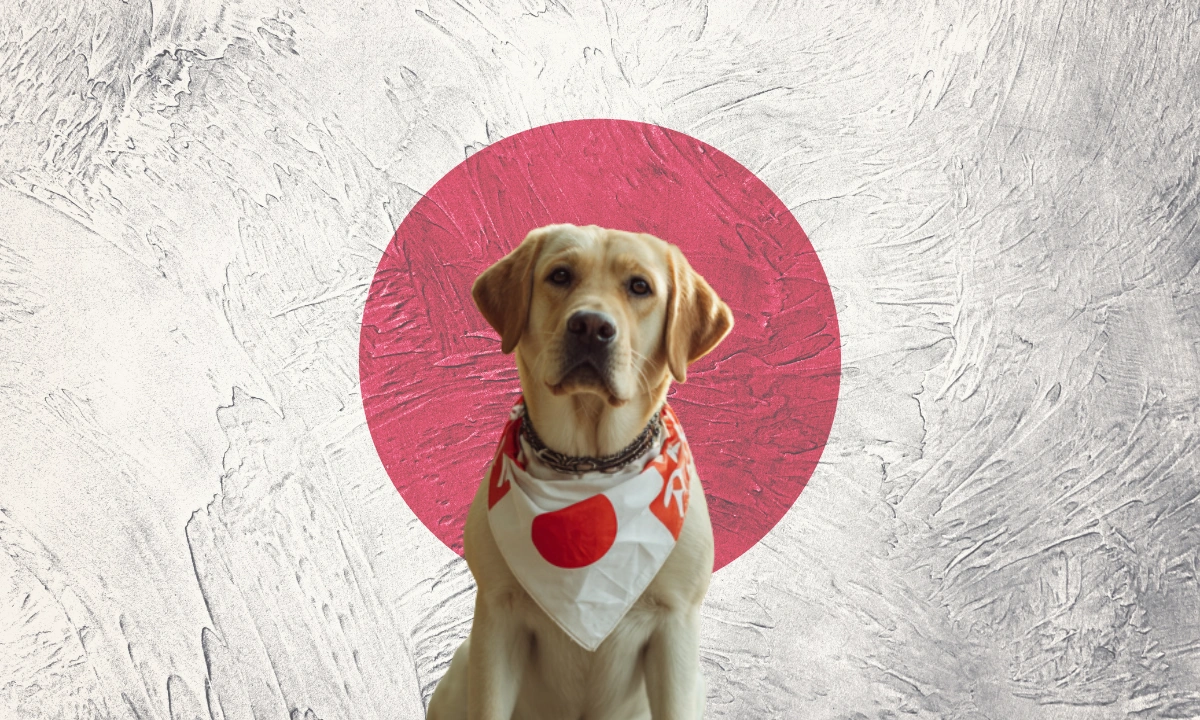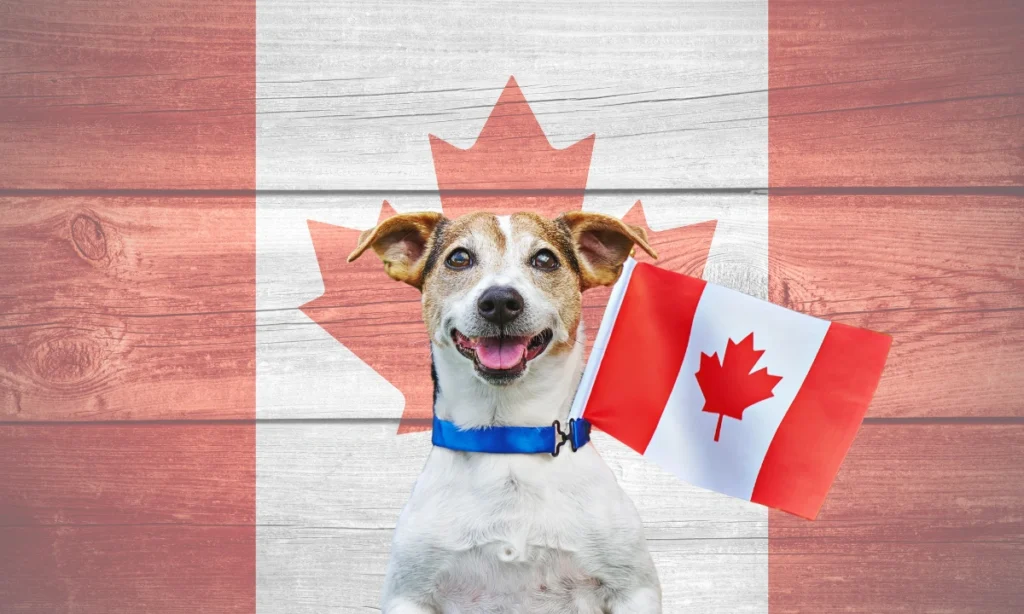Planning a move to Japan is exciting, with new food, new culture, and new places to visit. Of course, you want your pet beside you for all of it.
Leaving your dog or cat behind simply isn’t an option. We feel the same way. Pets are family, and the journey is not complete unless they come too.
But it’s normal to feel unsure about bringing your pet to Japan from Australia. You may be wondering about:
- Quarantine rules
- Pet eligibility requirements
- Vet inspections and vaccinations
Japan does have strict biosecurity regulations, and the steps can seem overwhelming at first glance. The good news is that the process is very manageable when you understand the steps and start preparation early.
After reading this guide, you’ll know exactly what to do and when to do it. And we’re always here to handle the entire process if needed, making your pet’s journey to Japan safe and stress-free.
Let’s dive in.
Is My Pet Eligible for Transport to Japan?
Before organising flights or appointments, make sure your pet is eligible for import to Japan from Australia. Japan protects its environment and public health through strict quarantine rules, but because Australia is designated as a rabies-free region, the process is a little easier for some pets.
Dogs and Cats
Bringing your domestic dogs and cats to Japan falls under this simplified pathway. Other pets (such as rabbits, birds, reptiles, or rodents) are subject to different regulations and may not be permitted.
Hybrid animals with wild ancestry, such as wolfdogs or savannah cats, may require additional consideration.
If your pet falls into this category, speak with one of our experts early to confirm eligibility.
Generally, if your companion is a domestic dog or a cat, you can move forward confidently.
Residency Requirement in Australia
Your pet must have lived in Australia long enough to qualify for direct entry. They must meet one of the following conditions:
- They have lived in Australia since birth
- They have lived in Australia for at least 180 days before travel
- They were originally imported from Japan and have remained in Australia since
If your pet has spent time in another country recently, and their total time in Australia is less than 180 days, Japan requires quarantine on arrival to make up the remaining days.
For example, say your dog spent 160 days in Australia before travelling to Japan, they would have to complete 20 days of quarantine in Japan.
This is why it’s important to confirm residency dates early. Dogtainers can help check this to avoid any surprises.
Your Responsibility as the Importer
The “importer” (person planning to import dogs or cats) is responsible for the following obligations at his or her own expense. You should begin the importation procedure only after fully understanding and accepting these obligations.
- Inspections and treatments in the exporting country
- Advance notification
- Obtaining all necessary documents, including certificates
- Arrangements for transportation
- Application for an Import Inspection upon arrival in Japan
- Measures and expenses for quarantine at a detention facility (if necessary)
- Reshipment if import is not permitted
- Other matters that an animal quarantine officer may instruct as necessary
Dogtainers helps every step of the way, with experts following the process precisely.
Step-by-Step Process (Start Early)
The international pet transport process is very structured, and Japan’s import process is no different, so completing every step in the right order is essential. Starting early gives you enough time to gather documents, complete veterinary checks, and avoid delays.
The step-by-step process below is your roadmap for bringing your pet to Japan from Australia.

Step 1: Microchipping
Your pet must have a microchip implanted before any paperwork begins.
The microchip must be ISO 11784 or 11785 compliant.
This microchip number will appear on every document, so it must be readable at each stage of the process. If the number cannot be read or it doesn’t match documentation when your pet arrives in Japan, your pet will need to quarantine for 180 days or be returned at your expense.
As you can see, the microchip is vital for bringing your pet to Japan.
Key points:
- Ask your vet to confirm the chip meets ISO standards
- Ensure the chip number is recorded correctly at every appointment
- Keep the number written down in multiple places
Double-checking the microchip number at each stage keeps the process going smoothly.
Step 2: Confirm Residency Requirement
We’ve already touched on this above. But it’s always helpful to confirm the residency requirements as part of the process.
Your pet must meet ONE of the following residency conditions:
- Lived in Australia since birth
- Lived in Australia for at least 180 days before travel
- Returned from Japan and has remained in Australia since
If your pet has spent less than 180 days in Australia, quarantine is required in Japan.
Dogtainers can help you confirm this if you’re unsure.
Step 3: Advance Notification (At Least 40 Days Before Arrival)
You must notify the Animal Quarantine Service in Japan at least 40 days before arrival.
Sending an official Notification Form to the quarantine office at your planned arrival airport covers this. After review, Japan will issue an Approval of Import Inspection of Animals, a key document needed for travel.
We recommend submitting your notification as early as possible to allow time for corrections if needed.
Here are some of the details associated with the Notification Form:
- Date of birth (Age): If the date of birth is unknown, enter the age of the dog or cat at the time of arrival
- Scheduled place of arrival: Name of the expected arrival airport or seaport
- Consignor: The person exporting or travelling with the dog or cat from abroad
- Consignee: The person receiving the dog or cat upon arrival in Japan
- Date of identification: The date that the microchip was implanted
- Cargo or hand luggage: The type of transportation (This will be cargo when flying from Australia)
- Name and address of destination: Place where the dog or cat will be kept after import into Japan
If your travel plans change (airport, date, animal details), you must submit a Modification Notice before travel.
The following changes may not be accepted as they may affect the import inspection:
- Advancing the arrival date
- Increasing the number of imported animals
- Replacing with different animals
- Changing the importation schedule after the scheduled arrival date
We have vast experience in bringing pets from Australia to Japan. Our experts can guide you through any scenario (we’ve seen it all).
Step 4: Pre-Export Veterinary Inspection (Within 10 Days of Departure)
A vet must examine your pet within 10 days before travel. If this isn’t possible due to circumstances in the exporting country, an earlier inspection may be accepted.
During this check, the vet confirms:
- Your pet shows no signs of rabies (dogs and cats)
- Your dog shows no signs of leptospirosis
- The microchip can be scanned and verified
This appointment ensures your pet is healthy and fit for travel.
Note: An experienced Dogtainers vet will perform this inspection if you book pet transport with us. Our vets are experts in this process and know exactly what paperwork is required.
Step 5: Obtain Government-Endorsed Export Permit
After the veterinary inspection, you must obtain an official export permit for Australia. This confirms all requirements have been met, including:
- Microchip number
- Residency qualification
- Health inspection results
- Any vaccinations or parasite treatments
- Transport crate seal number (if applicable)
Japan’s import authorities provide recommended Form A/B templates for this permit to avoid excluding details.
Of course, we know this process inside and out and ensure everything is completed correctly.
With pet vaccinations, we advise they’re up to date for international travel (even if they’re not specifically required).
Recommended vaccinations for dogs (C5 vaccination) are:
- Distemper
- Hepatitis
- Parvovirus
- Para-influenza
- Bordetella bronchiseptica (kennel cough)
Recommended vaccinations for cats (F3 vaccination) are:
- Feline enteritis (panleukopenia or feline parvovirus)
- Feline calicivirus
- Feline herpesvirus (feline viral rhinotracheitis)
Your pets should also be up to date with their internal and external parasite treatments.
Step 6: Transport Requirements and Flight Planning
A direct flight from Australia to Japan is the simplest and most stress-free option for your pet.
If you must transit through a non-designated region, one of the following must occur:
- The pet crate is sealed with an official tamper-evident seal
- You obtain an ANNEX transport certificate confirming your pet had no contact with other animals during transit
The crate your pet travels in must be IATA-approved and:
- Be secure and escape-proof
- Allow your pet to stand, turn, and lie down comfortably
- Provide good ventilation
Dogtainers can help select and size the right crate for your pet’s comfort and safety.
Once you complete these steps, your pet is ready to travel. The next stage takes place upon arrival in Japan.
Step 7: Arrival in Japan (What to Expect)
After landing in Japan, your pet must complete an import inspection before they can go home with you. Authorities should complete this within 12 hours.
Knowing what will happen during this stage helps reduce stress and ensures you’re prepared.
Import Inspection at the Airport
Your pet will be taken to the Animal Quarantine Service office at the airport for inspection. Authorities inspect the following:
- No abnormality is found in the health condition of the dog or cat – target diseases: rabies (for cats and dogs) and leptospirosis(for dogs).
- The microchip number matches the numbers on all the certificates (checked by scanning the microchip).
- The certificate is issued or endorsed by the government agency of the exporting country.
- The contents of the certificates issued by the government agency of the exporting country meet the requirements for importing dogs and cats into Japan.
- If transported through non-designated regions (transit), the transit conditions are met (listed in the previous section).
If paperwork is in order and your pet appears healthy, the process is straightforward.
Pets entering Japan from Australia should complete quarantine within 12 hours. Often, it takes only a few hours before release.
If Everything Is in Order
Your pet will be cleared, and you will receive an Import Quarantine Certificate. This certificate is important. Keep it safe, as you may need it for:
- Pet registration with your local municipality (for dogs)
- Future veterinary visits
- Any future export preparation
Once cleared, your pet can leave the airport with you and begin settling into life in Japan.
If Requirements Are Not Met
If documents are missing, incorrect, or the microchip does not match, your pet will be transferred to a detention quarantine facility managed by the Animal Quarantine Service.
This quarantine may last up to 180 days, depending on what requirements are incomplete.
During quarantine, you:
- Are responsible for care-related costs
- May be able to visit your pet, depending on the facility’s schedule
This is why following each preparation step carefully is so important.
After Arrival (Settling In)
Once your pet has cleared inspection, you can focus on helping them adjust to their new surroundings. Even confident pets may feel unsettled after a long journey, so gentle support during the first few days makes a big difference. The goal is to help your pet feel safe, calm, and connected to you.
Registration and Vaccination Requirements
In Japan, dog owners have two important responsibilities under local law:
- Register your dog with the local city or ward office within 30 days of import
- Ensure your dog receives a yearly rabies vaccination
Microchip registration is optional, but we highly recommend it. If your dog or cat gets lost, authorities can identify you if the microchip number is in their system.
You’ll need to show your Import Quarantine Certificate when registering your dog. This certificate proves that your pet entered the country legally and passed quarantine inspection.
Cats do not require registration or yearly rabies vaccinations under Japanese law. However, regular health checks are still recommended.
Helping Your Pet Settle Comfortably
After a long journey, your pet may need time to decompress. You can help in the following ways:
- Keep the environment quiet, especially during the first 24–48 hours
- Offer familiar bedding or toys with your scent for comfort
- Stick to a predictable feeding and exercise routine
- Allow your pet to explore at their own pace
Give extra reassurance through calm presence and gentle interaction. Pets take cues from us, and relaxed, steady energy helps them feel secure.
With a little patience and routine, most pets settle in beautifully and adapt quickly to their new environment.
Finding a Local Veterinarian
Choosing a new vet early is important for ongoing health and compliance. Look for:
- Clinics that offer English language support (common in urban areas)
- Vets familiar with imported pets and travel-related stress
- Access to emergency care if needed
A post-arrival check-up is a good opportunity to review vaccination schedules and parasite prevention. And it never hurts to get your pet checked over after travel.
Bringing Your Pet to Japan from Australia with Dogtainers
Although bringing your pet to Japan from Australia takes attention and preparation, it doesn’t have to be stressful. With Dogtainers, our experts help you every step of the way to ensure every stage of the process is completed correctly.
We guide you through everything, from advising you on pet eligibility to arranging vet inspections. You don’t have to go through the process alone.

Our experts have been helping pet owners like you with international pet transport for over 50 years. We’re Australia’s oldest and most reliable pet transport company with:
- Vast experience
- Industry credentials
- Tailored services
- Reliable global networks
- Strong airline partnerships
- Deep regulatory knowledge
Conclusion
Bringing your pet to Japan from Australia takes preparation and patience. The process is detailed, but each step exists to protect your pet’s health and ensure they arrive safely.
When you start early, stay organised, and follow the steps in order, the journey becomes much smoother. And having your pet with you in Japan is worth every form, every check, and every preparation step.
If you feel unsure at any stage, you don’t have to manage it alone.
Dogtainers has supported families, travellers, and their pets for more than 50 years. Our team understands the process in detail, and we’re here to help guide you through it with care and clarity for a stress-free journey.
Get your quote today for relocating your pet from Australia to Japan.
Your new life with your pet in Japan is waiting.
Bringing Your Pet to Japan from Australia FAQ
1. How early should I start preparing to bring my pet to Japan from Australia?
Begin planning at least three months before departure. This allows time for microchipping, notifications, paperwork, and veterinary checks. Starting earlier also lets you better prepare your pet for the journey.
2. Does my pet have to quarantine when arriving in Japan?
If all requirements are met correctly, quarantine usually lasts less than 12 hours. But quarantine may be extended up to 180 days if requirements are not met or if the paperwork is incorrect.
3. What happens if the microchip number doesn’t match the paperwork?
The microchip must match every document. If it cannot be verified, your pet may be held in quarantine or sent back to the exporting country at your expense.
4. Can my pet travel in the cabin with me on the flight to Japan?
No, pets generally travel as manifest cargo on international flights from Australia. They travel in the cargo hold in a separate department from the baggage. The captain monitors the temperature here (the same as in the cabin), and it’s safe for pets.
5. Do I need to register my pet once we are living in Japan?
Dogs must be registered with the local municipality within 30 days. They also require yearly rabies vaccinations. Cats do not require registration. We also recommend registering your pet’s microchip so authorities can contact you if your pet gets lost.





Share this article